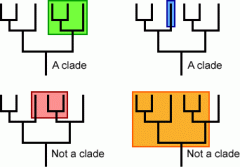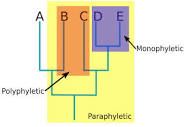![]()
![]()
![]()
Use LEFT and RIGHT arrow keys to navigate between flashcards;
Use UP and DOWN arrow keys to flip the card;
H to show hint;
A reads text to speech;
54 Cards in this Set
- Front
- Back
|
allele |
One of several alternative forms of the DNA sequence of the same locus. |
|
|
homology |
homologous trait similar in two or more species because they are inherited from a common ancestor. |
|
|
blending inheritance |
the expression in offspring of phenotypic characters (as pink flower color from red and white parents) intermediate between those of the parents |
|
|
inheritance of acquired characteristics |
Lamarck's theory If an organism changes during life in order to adapt to its environment, those changes are passed on to its offspring. |
|
|
polymorphism |
Polymorphism is a condition in which a population possesses more than one allele at a locus. Sometimes it is defined as the condition of having more than one allele with a frequency of over 5% in the population. |
|
|
The modern synthesis |
a theory about how evolution works at the level of genes, phenotypes, and populations. a consolidation of the results of various lines of investigation that supported and reconciled the Darwinian theory of evolution and the Mendelian laws of inheritance in terms of natural selection acting on genetic variation. |
|
|
indel |
used to mean an insertion or a deletion and indels simply refers to the mutation class that includes both insertions, deletions, and the combination thereof, including insertion and deletion events that may be separated by many years, and may not be related to each other in any way. |
|
|
heterozygosity |
Relating to a cell that has two different alleles at corresponding positions on homologous chromosomes. |
|
|
heritability |
the extent to which offspring resemble their parents more than an individual chosen randomly from the population. |
|
|
genetic drift |
change in frequency of traits (alleles) due to chance events. |
|
|
microevolution |
Evolution occurring within populations, including adaptive and neutral changes in allele frequencies from one generation to the next. |
|
|
mutation |
Any change to the genomic sequence of an organism. |
|
|
exaptation |
A trait that originates performing one function, and which is later co-opted for a new function. |
|
|
molecular clock |
A method used to determine time based on base-pair substitutions. molecular clocks use the rates of molecular change to deduce the divergence time between two lineages in a phylogeny, for example. they work best when they can be "calibrated" with other markers of time, such as fossils with known ages. |
|
|
evolution |
Biological evolution is any change in the inherited traits of a population that occurs from one generation to the next. Only occurs when frequencies of alleles change within a population. |
|
|
synapomorphy |
A shared derived character (i.e., one that evolved in the immediate common ancestor of a clade and was inherited by all its descendents). |
|
|
plesiomorphic character states |
The ancestral character state - inherited from distant ancestors. E.G. From the point of view of Primates, having five fingers is a plesiomorphy. |
|
|
clade |

A single "branch" in the tree of life representing an organism and all of its descendents. |
|
|
paraphyletic group |

a group of organisms that includes an ancestor but not all of its descendants. |
|
|
convergent evolution |
The independent origin of similar traits in separate evolutionary lineages. |
|
|
biomarker |
Molecular evidence of life in the fossil record. Biomarkers can include fragments of DNA, molecules such as lipids, or isotopic ratios. |
|
|
fitness |
a measure of how well designed is an organism to function in a given environment. A function of survival and reproductive success. |
|
|
igneous rocks |
formed through the cooling and solidification of magma or lava. |
|
|
sedimentary rocks |
formed by the deposition of material at the Earth's surface and within bodies of water. Sedimentation is the collective name for processes that cause mineral and/or organic particles (detritus) to settle and accumulate or minerals to precipitate from a solution. |
|
|
metamorphic rocks |
Rock that was once one form of rock but has changed to another under the influence of heat, pressure, or some other agent without passing through a liquid phase. |
|
|
fossilized trackways |
a type of trace fossil, a trackway made by an organism. Many fossil trackways were made by dinosaurs, early tetrapods, and other quadrupeds and bipeds on land. |
|
|
phylogenetics |
branch of life science concerned with the analysis of molecular sequencing data to study evolutionary relationships among groups of organisms. |
|
|
homoplasy |
Character state similarity not due to shared descent (e.g. produced by convergent evolution or evolutionary reversal). |
|
|
principle of parsimony |
the scientific principle that things are usually connected or behave in the simplest or most economical way, especially with reference to alternative evolutionary pathways. |
|
|
outgroup |
A group of organisms (species) that is outside of the monophyletic group under consideration, but closely related to that group. in phylogenetic studies, outgroups can be used to infer the ancestral states of characters. |
|
|
root of a phylogenetic tree |
provides information about the order of nodes in the tree. |
|
|
polyploidy |
cells and organisms are those containing more than two paired (homologous) sets of chromosomes. |
|
|
gene expression |
The process by which information from a gene is transformed into a product. |
|
|
transposable elements |
a DNA sequence that can change its position within the genome, sometimes creating or reversing mutations and altering the cell's genome size. |
|
|
synonymous substitution |
Mutations that do not alter the amino acid sequence of a protein. Because these mutations do not affect the protein an organism produces, they are less prone to selection and often free from selection completely. |
|
|
nonsynonymous substitution |
a nucleotide mutation that alters the amino acid sequence of a protein. |
|
|
nonsense substitution |
the substitution of a single base pair that leads to the appearance of a stop codon where previously there was a codon specifying an amino acid. |
|
|
frameshift mutation |
is a genetic mutation caused by indels (insertions or deletions) of a number of nucleotides in a DNA sequence that is not divisible by three. |
|
|
polyphenic trait |
single genotype produces multiple phenotypes depending on environment. |
|
|
quantitative trait |
Continuously varying traits. Influenced by multiple genes; generate a normal distribution. |
|
|
phenotypic plasticity |
Changes in the phenotype produced by a single genotype in different environments. |
|
|
evolutionary coalescence |
The process by which, looking back through time, the genealogy of any pair of homologous alleles merges in a common ancestor. |
|
|
lineage sorting |
The process by which, following separation of two species, the ancestry of every gene converges to the overall phylogeny of the species. This process takes about 2Ne generations, and incomplete lineage sorting implies discordance between genealogies. |
|
|
evolutionary substitution |
Substituion is the replacement in a population of one nucleotide or amino acid by another. |
|
|
mutational saturation |
the reduced appearance, which occurs over time, of sequence divergence rate that results from reverse mutations, homoplasies and other multiple changes occurring at single sites along two lineages. |
|
|
polygenic trait |
Influenced by multiple genes. |
|
|
epistasis |
Occurs when the effects of an allele at one genetic locus are modified by alleles at one or more other loci. |
|
|
directional selection |
Selection favoring one allele over another or favoring increased values of a quantitative trait (Some characteristic that may be influenced by multiple genes). It is equivalent to positive selection. |
|
|
disruptive selection |
Selection favoring extreme values of a trait. |
|
|
stabilizing selection |
Selection that favors intermediate trait values. |
|
|
multiregional model of human origins |
The hypothesis that different hominins found across the Old World (such as Homo erectus and Homo neanderthalensis) evolved in situ into modern human populations. |
|
|
out of Africa model of human origins |
The hypothesis that modern humans evolved recently in Africa and spread from there, replacing archaic hominins. |
|
|
Neutral theory of molecular evolution |
The theory that genetic variation is neutral and is shaped primarily by mutation and random genetic drift. (neutral evolution: Evolving without the influence of natural selection.) |
|
|
How long ago did the first life on earth appear? |
3.5 billion years ago |

